How Will Blockchain Impact Healthcare? Tech Leaders Weigh In
Blockchain has been touted as a solution with the potential to revolutionize how businesses manage data and identity by increasing transparency and trust across a wide range of industries.
But what does it mean for healthcare delivery and management? To answer that question, HealthTech magazine convened a panel of thought leaders at the intersection of blockchain and healthcare IT.
Our roundtable consisted of Jason Goldwater, senior director at healthcare tech consultancy the CedarBridge Group; Tim Mackey, associate professor at the University of California, San Diego School of Medicine; Maria Palombini, Director of Emerging Communities & Initiatives Development, Global Business Strategy & Intelligence, for the IEEE Standards Association; and Dr. John Halamka, CIO of Beth Israel Deaconess Medical Center and editor in chief of Blockchain in Healthcare Today.
We spoke with them about the basics of blockchain, misconceptions about the solution, use cases for the industry and more.
HEALTHTECH: How do you describe blockchain to less tech-savvy colleagues?
GOLDWATER: I often describe blockchain as a modern-day accounting system for data, minus the accountants. It’s based on a general ledger system that collects information from numerous sources and updates that data as new elements are continually introduced.
The data is owned by everyone in the chain, and no one individual has control over all of it. It’s an immutable and robust way to collect and store hundreds of thousands of data elements.
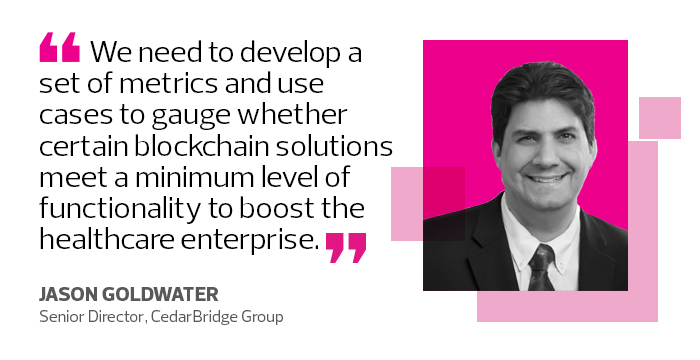
MACKEY: I ask them to think about data that is related, like their digital health records, but comes from multiple sources that are not connected. Wouldn’t it be great if everyone could access that data and agree that it was accurate and trustworthy? That’s what blockchain architecture can do.
PALOMBINI: I say, “Imagine if you had a digital lockbox that contained every element of your personal health profile. You can decide when, where, how, what and who you want to share with, while retaining your privacy, then use that data to get better health service. Would that be appealing to you?”
HALAMKA: I’m a vegan, so I really hate using this example, but: Imagine you have a cow and make corned beef hash. I think you’d agree it’s really hard to turn corned beef hash back into a cow — it’s a one-way transformation. Blockchain is a decentralized public ledger that anyone can read and ensures data integrity using cryptographic one-way transformations that are unique but consistent.
The transformations are linked, with each one dependent on the last. We can prove data wasn’t changed by showing that data transformed today matches the transformation done in the past.
If any part of the chain is altered, the transformations will no longer match.

HEALTHTECH: What will be blockchain’s greatest impact on the healthcare industry?
GOLDWATER: There will be three major impacts on the industry.
One is higher-quality data about patient care. Blockchain allows you to gather information from multiple sources — IoT devices, smartphone apps, patient portals — and send it to healthcare providers, who can monitor the quality of care on a longitudinal basis. Providers will know what interventions are needed, while patients will gain greater control over their data.
This will help spur greater participation in patient-reported outcome performance measures, which will improve quality measurement.
The third benefit is streamlining payments. Using blockchain to document different clinical encounters for each patient helps payers understand what services were being provided, allowing for easier distribution and coordination of payments.
MACKEY: Blockchain will unlock data silos of individual patient health information and give consumers ownership of their digital health identity. That, in turn, could help inform Big Data health analytics, revolutionizing the way we conduct surveillance for risk and protective factors associated with diseases.
The potential public health benefits are immense.
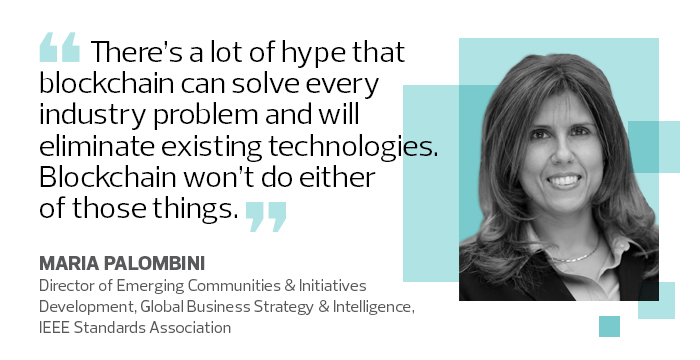
PALOMBINI: Precision medicine is based on two core principles: data and science. Blockchain has the ability to shift precision medicine from a trial concept to common practice by addressing the major challenges surrounding not only patient information collection, but also sharing and utilization that is needed in the art of precision medicine.
If patient-centric identity becomes a reality on blockchain, health providers would have a clear longitudinal view of each patient; prognosis, treatment and prevention guides would be based on the validated and verified characteristics tied to the patient’s profile.
Blockchain would allow this data to be collected and shared in a way that protects patients’ privacy and keeps them as central partners in the process.
HALAMKA: Since it is a public ledger that you write and never erase, it’s a perfect audit trail. We can use it to ensure medical records are not altered, to guarantee that clinical trials were done without fraud, and to record consent preferences using a blockchain feature called smart contracts.
The principal benefit is creating trust: Information is recorded publicly and cannot be changed. This will benefit any stakeholder in the ecosystem who wants to ensure data integrity.
Standard database technology cannot provide that level of assurance. It’s a perfect application for blockchain.
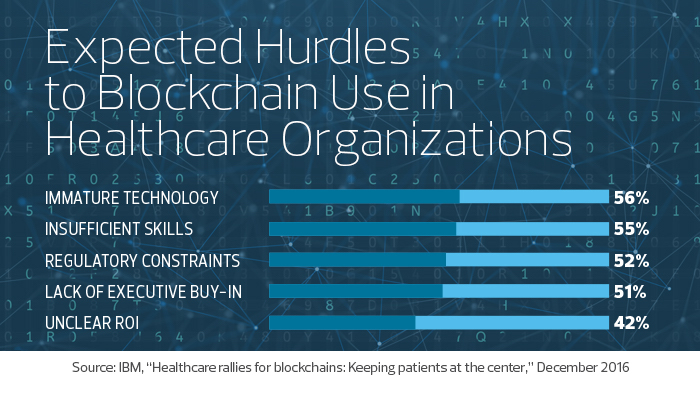
HEALTHTECH: What are the biggest misconceptions people have?
GOLDWATER: There’s a fear that healthcare providers will become flooded with information and will never keep up with their patients. They don’t realize there are controls on what data is sent, and that it requires engagement between both a provider and a patient.
MACKEY: The biggest misconception is that blockchain is bitcoin. It’s hard to differentiate between what’s happening in the wild, wild west of initial coin offerings versus integrating enterprise approaches to business blockchains.
PALOMBINI: There’s a lot of hype that blockchain can solve every industry problem and will eliminate existing technologies. Blockchain won’t do either of those things.
At the IEEE Standards Association, we work with blockchain technologists and other stakeholders across the health ecosystem to drive consensus on technical standards that will allow blockchain to interoperate with existing technology platforms.
In addressing the industry problem you want to solve, it is best to first define the use case and then decide if blockchain is the right solution, not the other way around.
HALAMKA: People mistakenly think that it’s a database, an analytics tool, a fast/scalable platform, an interoperability solution, a user-friendly platform, or that it will replace electronic health records. How many transactions a second at Beth Israel Deaconess do we have in our EHR? 12,000. What is the total throughput of the blockchain today? Seven transactions a second.
Remember, the blockchain is a ledger of data integrity. It is not a database. Anyone who believes that doesn’t understand blockchain.
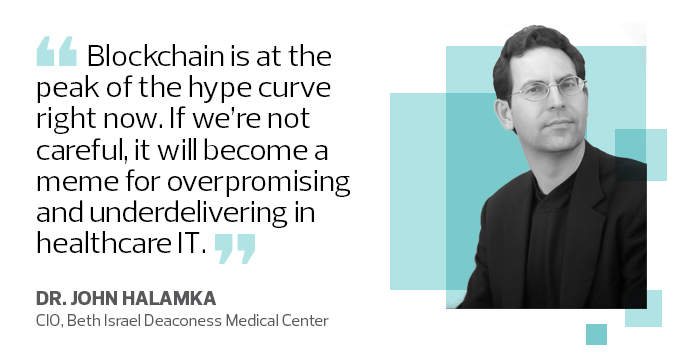
HEALTHTECH: What are the strongest barriers to adoption?
GOLDWATER: There are still a large number of providers and payers that do not understand this technology or how to apply it. There also are a large number of companies building blockchains for use in healthcare with no framework to evaluate functionality or applicability.
We need to develop a set of metrics and use cases to gauge whether certain blockchain solutions meet a minimum level of functionality to boost the healthcare enterprise.
MACKEY: Some of the biggest barriers are familiar ones: privacy and policy. HIPAA and GDPR come to mind first, but more specifically, what constitutes PHI versus consumer health information, and the privacy laws and regulations that impact its sharing and de-identification. These factors put the healthcare sector in a unique industry of risk.
And don’t forget that domestic health policy is a political minefield; policy flux and uncertainty make it hard to develop solutions that map to healthcare incentives and payments.
PALOMBINI: The biggest barrier is not the technology or interoperability, it’s process and protocols. The biggest question before us is, how do we incentivize the parties who have benefited from “proprietarizing” patients’ health data to relinquish ownership of that data?
HALAMKA: Blockchain is not an interoperability, telemedicine or identity management solution. The use cases for blockchain have to be carefully specified so they make sense.
Blockchain is at the peak of the hype curve right now. If we’re not careful, it will become a meme for overpromising and underdelivering in healthcare IT.
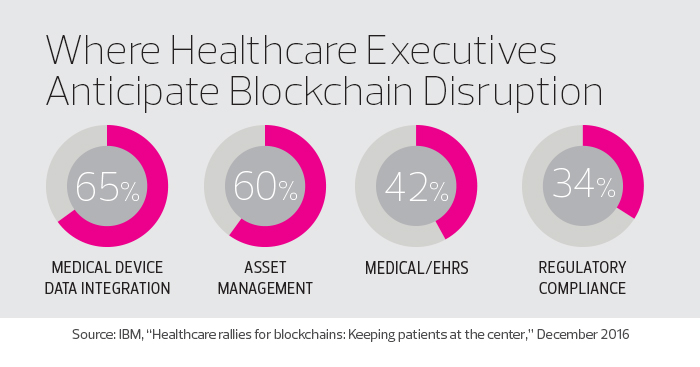
HEALTHTECH: Will blockchain in health go mainstream? If so, when?
GOLDWATER: We are still a few years away. The problem is not really a technical one, it’s a business and cultural one.
A number of solutions can be developed, but we will need to determine their applicability, their effectiveness and their ability to scale to multiple providers and health systems, as well as patients and payers. For now, we still need to explain what this technology is, how it can be used and what the implications are.
MACKEY: In certain healthcare verticals, blockchain adoption will happen quite rapidly. For example, in the clinical trial space there are clear benefits that pharmaceutical companies and the FDA are already advancing on, such as better patient recruitment, obtaining consent from participants in trials using smart contracts, and ensuring the validity of clinical trial data and protocols.
In other verticals, like supply chain, it will be slower due to concerns about data confidentiality, the cost of compliance, and the conflicting interests of different trading partners, such as logistics providers and manufacturers.
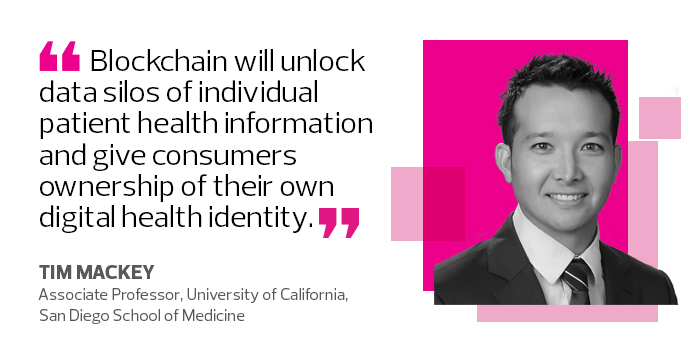
PALOMBINI: I don’t believe we’ll ever have 100 percent compliance in healthcare. Even now, some doctors don’t have websites and some patients don’t email.
However, over the next two to four years, I do envision an increase in
discussions around outcomes from proofs of concept and pilots, as well as outcomes from partial implementations on public blockchain projects that come out of consortia and working groups.
HALAMKA: In the next few years I think it will become widely used for audit trails, clinical trials management and consent tracking. Practicing doctors can expect blockchain to be an invisible technology deployed behind the scenes that provides enhanced security and information verification as practices more and more depend upon the use of digitized information.
Blockchain for healthcare is early in its lifecycle, but it has potential to standardize secure data exchange in a less onerous way than prior approaches.









